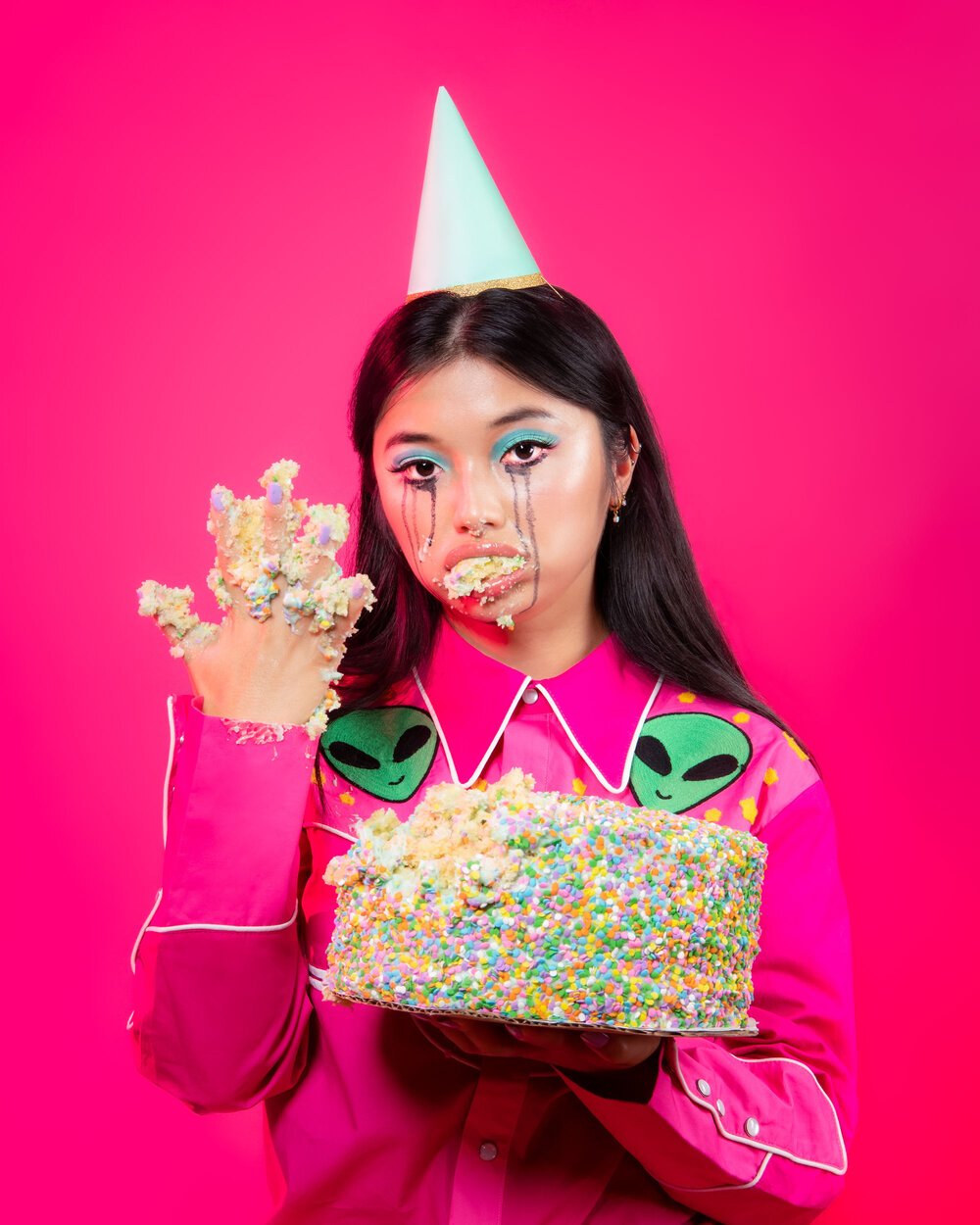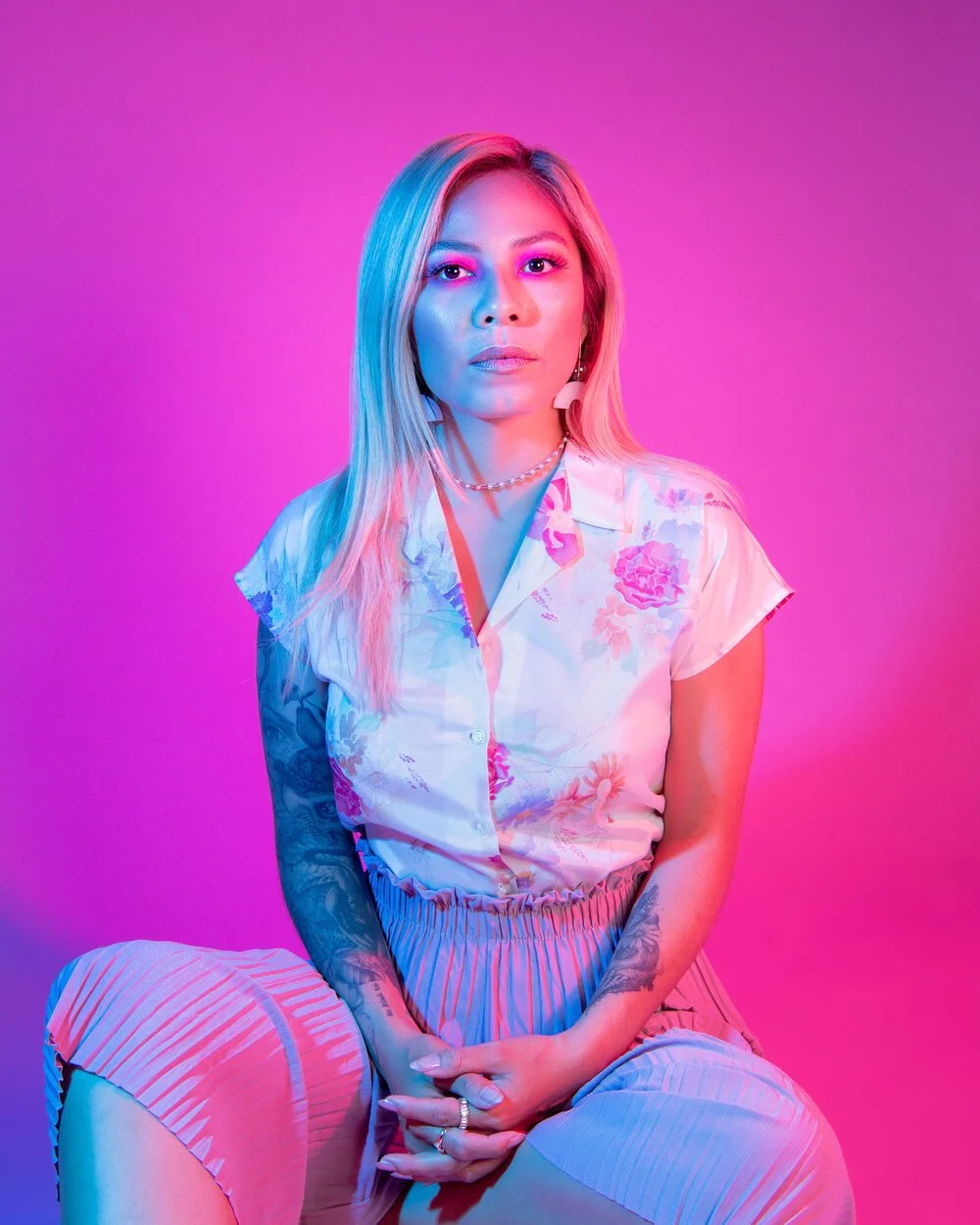Lee Jameson: All Womxn
February 6th, 2021
LA based Lee Jameson is bringing pop colours and a minimalist eye to contemporary portraiture. With a sense of humour and a nod to retro aesthetics, her images are bright, bold and pack a visual punch. A true celebration of all womxn, Lee’s works are full of care and a love for her subjects and their personal visions and voice. We caught up with Lee to talk inspiration, politics and entrepreneurialism in the creative community.
POL: First up, can you introduce yourself to our readers and how you would describe your photography?
LJ: I’m a creative portrait and fashion photographer primarily focusing on highlighting intersectional feminist subjects and spaces in Los Angeles. My work is shot in-studio with colourful lighting and bold backdrops. My subjects often include comedians, artists, womxn entrepreneurs, eccentric personalities and offbeat fashion brands.
POL: Your portraits, whilst visually bold and colourful, are quite minimalist set-ups with just a model and colour backdrop, and are nearly entirely shot in the studio. Where did this aesthetic purity come from? What is it about this set-up that makes you want to return back to it time and time again?
LJ: I love shooting in the studio and having complete control over the lighting and environment. I don’t enjoy working outdoors to be honest. Shadows around subjects irk me, I always want them removed, and that is probably why I love a minimalist color backdrop and set so much visually. I want the final result to look almost a little too perfect and a bit otherworldly.
“I want the final result to look almost a little too perfect and a bit otherworldly.”
POL: Since your works are so much about the sitter you’re photographing, we’d love to know where you find your models? How do you go about getting people to sit for you?
LJ: My models are a mix of performers I admire, clients, models I discover on instagram and womxn entrepreneurs in Los Angeles. Depending on the project, I’ll reach out and connect with different subjects based on the look or subject matter of the shoot. I’ve been very lucky to be able to draw on so many brilliant creatives in LA to collaborate with.
POL: Colour is such an important part of your work too. You use a lot of primary colours and every one of your images has its own bold colour pallet. Where does your sense of colour aesthetic come from? What draws you to fearless use of colour?
LJ: I’ve always been drawn to bright, bold color and appreciate aesthetics that don’t shy away from playing with color - whether it’s interior design, film, fine art, etc. One of the biggest influences in my life has been the work of Spanish filmmaker Pedro Almodóvar and the ways in which his sets and costumes combine highly saturated colours that you wouldn’t typically think would work together. I think about his work a lot while designing and it inspires me to take risks.
“I’ve dedicated my work to supporting womxn creatives and entrepreneurs in LA because I want to use my platform to let them and their work shine - not only for one subset but for all womxn.”
POL: We were really drawn to you and wanted to speak with your about your work not only for our love of your visual style, but the fact that you are also using your platform as a photographer to shine a light on intersectional feminist subjects and spaces in Los Angeles. For any of our readers who perhaps don’t know what intersectional feminism is, could you explain what this means and why you’ve dedicated your work to highlighting it?
LJ: Intersectional feminism means inclusive feminism that takes into account all overlapping identities — including race, class, gender identity, disability, size, ethnicity, religion and sexual orientation — and how they impact the ways they experience oppression and discrimination. I’ve dedicated my work to supporting womxn creatives and entrepreneurs in LA because I want to use my platform to let them and their work shine - not only for one subset but for all womxn.
“I do hope that those in the creative industry in positions of power use their influence to support artists whose voices are not as often heard.”
POL: Do you think it is the responsibility for artists and those in the creative industry to focus on politics and sociological issues?
LJ: Ultimately it is up to the individual, but art is always political. And as the line between fine art and commercial work in photography becomes increasingly blurred because of how social media operates, it is very murky territory. Messaging can be exploited and misinterpreted very easily online. But I do hope that those in the creative industry in positions of power use their influence to support artists whose voices are not as often heard.
POL: How have you found being a female creator in an industry that is still dominated by men? Do you think it is changing? Where would you like to see photography as an industry be in five to ten years time?
LJ: I’m lucky to have found an extraordinary network of inclusive collaborators to surround myself with, but it can still be hard at times. There’s been a lot of positive change in the industry in terms of model representation in the last few years, but behind the scenes there is still a lot of work to be done. I hope to see a wider range of voices behind the scenes on big commercial shoots and in the photo rep world. It’s important to have production inclusivity guidelines in place in the photo industry to reinforce that because unfortunately when people are left to their own devices, they often just hire other creatives that look like themselves.
POL: Whilst these are serious topics, that isn’t to say your work can’t be hilarious at times. How important do you think a sense of humour is to your work? Do you think it is something missing from popular photography?
LJ: Thank you! I think it’s VERY important to have a sense of humour in photography and it’s something I prioritise and value. It can be missing from popular photography at times and that’s why I’m so drawn to the work of artists like Nadia Lee Cohen, who is a genius and great at creating oddball characters with loads of personality.
“I think it’s VERY important to have a sense of humour in photography and it’s something I prioritise and value.”
POL: Where did your passion for photography come from? Can you pinpoint seeing a particular artist or maybe a moment in your life where you fell in love with the medium?
LJ: I fell in love with studying photography during my internship at the Museum of Fine Arts, Houston. I organized and reviewed footage of Michael Almereyda’s 2005 documentary William Eggleston in the Real World, as well as Robert Frank’s entire film archives, and it was a life-changing experience getting to study their work.
POL: Photography wasn’t your first career, you started out in events and programming for indie films, so what was it that made you take the leap and change paths?
LJ: I spent my 20s producing events and programs for indie film festivals. It was deeply rewarding but I reached a point of burnout and illness that forced me to take a step back and reassess my career path. I did some soul searching and decided to dive head-first into building a photography career, which is what I really wanted all along.
POL: You aren’t just a photographer today though, you are a true entrepreneur with your own creative studio. How do you balance the demands of business (with all of the marketing, client juggling, editing, social media management, etc.) with being a creative and producing your own work?
LJ: I try to find a balance with my time management and set aside specified hours for client outreach, social media scheduling, test shoots, editing, etc. Later helps tremendously with organizing my social media output and Honeybook is great for streamlining client workflow. I also try to set aside time each week to explore other photographers’ work, master new editing techniques, and brainstorm creative ideas for future shoots.
POL: Coming from a cinema and media studies background, do you think this has had an impact on your visual style?
LJ: Absolutely! I love highly staged, intentional imagery with a specific vision behind it.
“I love highly staged, intentional imagery with a specific vision behind it.”
POL: Do you have any influences or photographers you look to for inspiration?
LJ: Some of my absolute favorite photographers are Nadia Lee Cohen, Kourtney Roy, Alex Prager, Philip-Lorca diCorcia, Adrienne Raquel, Gregory Crewdson, Gordon Parks, Sally Mann, Tierney Gearon, and Parker Day.
POL: If time and money were no object, is there a shoot or a project you would love to do?
LJ: You know, in a dream scenario a Vanity Fair or W Magazine shoot with an unlimited budget would certainly be a fantasy project. And I’d love to work on music videos!
POL: What are you working on now? What’s next for you?
PC: I just completed a “stay at home” quarantine themed shoot with fashion brand Magic Society, which was featured in Curious Magazine’s 2020 Womxn’s Issue. I’m currently looking to slowly and safely plan the next big project for 2021.
Images Featuring Makeup by: Yasmine Funches @baldeelockss, Faina Rudshteyn @fainafx, Ally McGillicuddy @allydoesmakeup, Carmonie Fuselier @carmonieaf, Kate Starkey @starkeymua, CiCi P @lookitscici.
About Lee Jameson
Lee Jameson is a Los Angeles-based creative portrait + fashion photographer and founder of Prismatic Studios LA. Her work primarily focuses on highlighting intersectional feminist subjects and spaces in Los Angeles. She's worked with creative spaces such as Junior High and Vidiots, fashion brands such as Magic Society, and talent including Dana Donnelly, Molly Lambert, Atsuko Okatsuka and Ashley Ray.
Lee has exhibited in the US and abroad. Her work was recently selected for exhibition in the 2020 5th Annual Creative Portrait Exhibition at the Los Angeles Center for Photography; as well as the 2020 International Exhibition at the Glasgow Gallery of Photography.















